Google Nexus 4 and Nexus 10 Performance Preview
by Anand Lal Shimpi & Brian Klug on November 2, 2012 11:00 AM ESTGPU Performance
This section is particularly exciting because it's our first look at ARM's new Mali-T604 GPU in our standard mobile 3D performance suite. We've already seen the Nexus 4's Adreno 320 in action, but the Nexus 10's behavior here should be interesting to see.
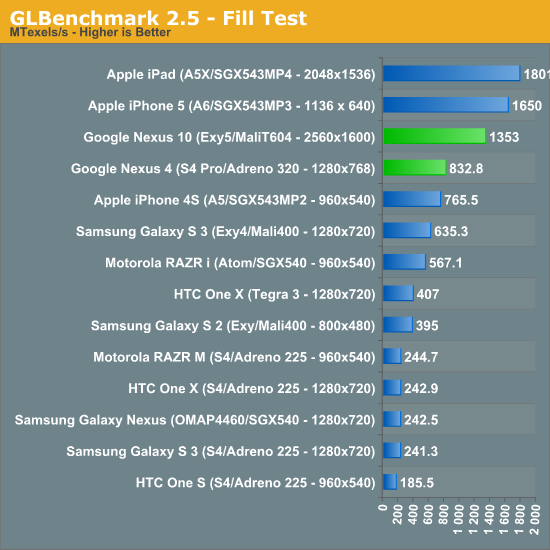
As far as raw fillrates are concerned, both Nexus devices do quite well here at their native resolutions. The iPad and iPhone 5 are both quicker, but we're still good gains over the previous generation of hardware - particularly for the Mali-T604. Compared to the Mali-400MP4 in the Galaxy S 3, we're seeing more than 2x the performance out of ARM's latest GPU.
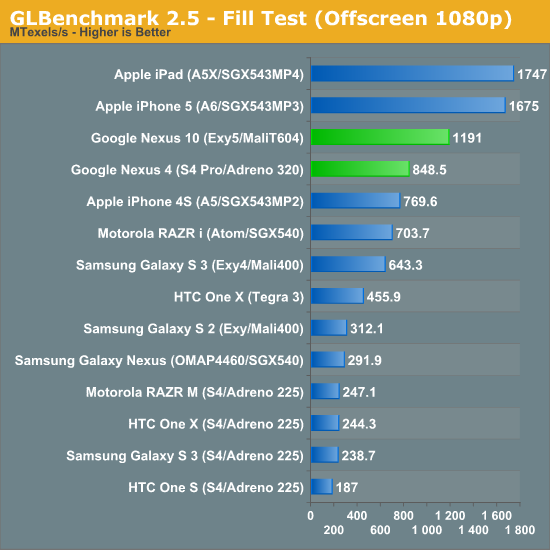
At normalized resolutions the standings don't really change.
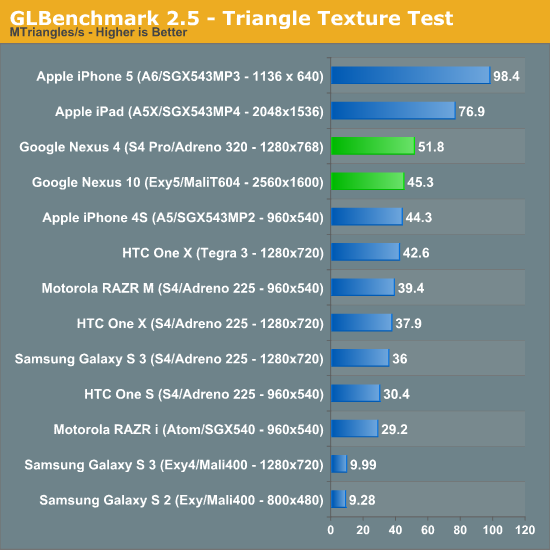
The T604 is ARM's first unified shader architecture, which gives it far more balanced pixel/vertex shader performance. The result is a more than 4x increase in triangle throughput compared to the Mali 400MP4. It's not enough to give the Nexus 10 the edge over the latest Apple devices, but it's a huge improvement over where ARM was in the previous generation. The Adreno 320 continues to be quite strong here as well.
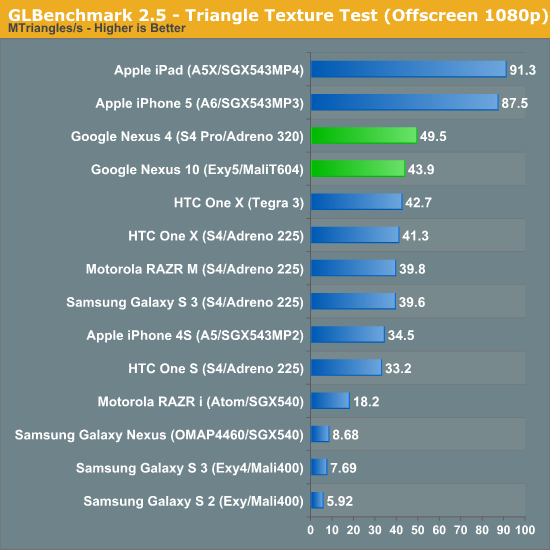
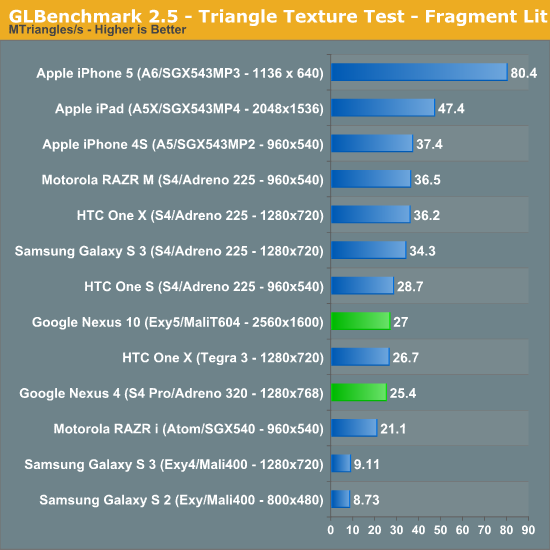
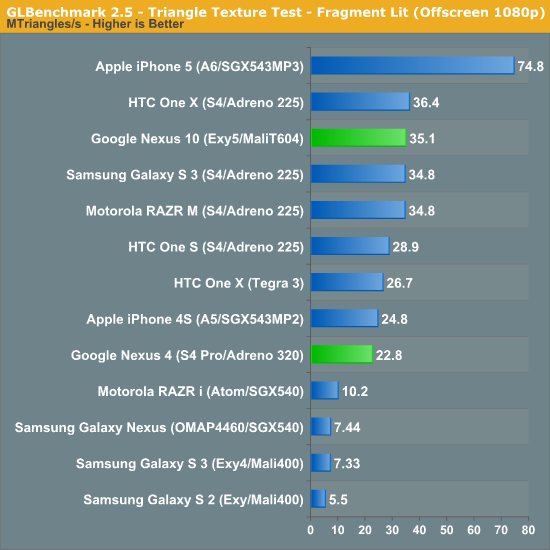
Once again we're seeing huge gains for the Mali-T604 compared to the Mali-400MP4. The Adreno 320 in the Nexus 4 actually performs worse than the Adreno 225 in older devices, possibly due to thermal throttling we saw on the Nexus 4 sample during periods of heavy load.
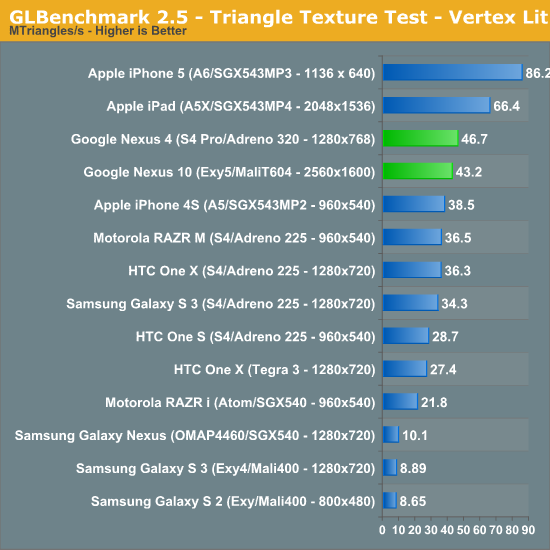
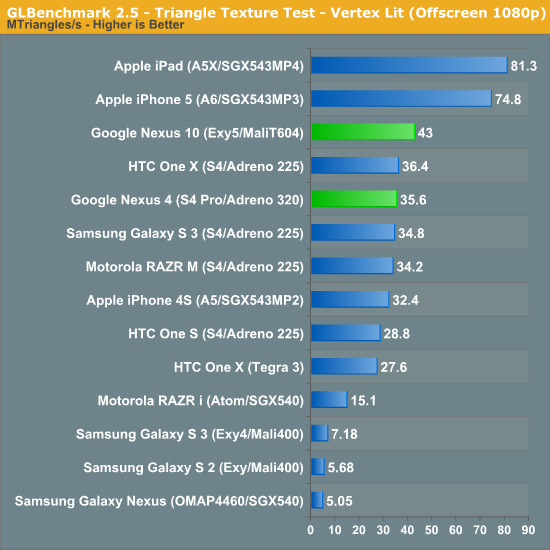
ARM shows the biggest gains here once again thanks to its move to a unified shader architecture. The Adreno 320 does ok here but it's really no better than the 225, I suspect there is some thermal throttling happening on the device.
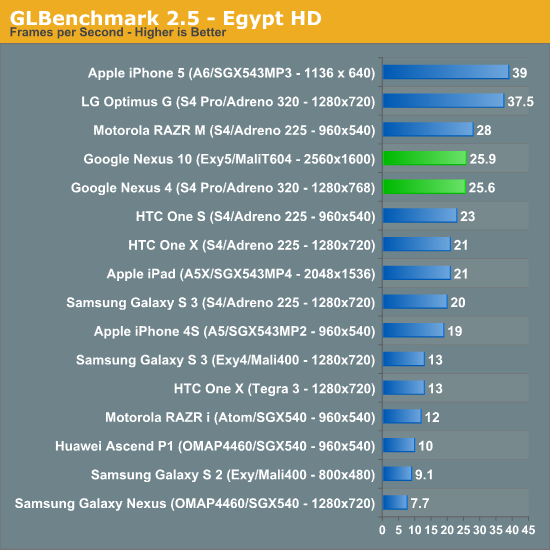
At native resolutions, the Nexus 10 and NExus 4 are both capable of putting out decent frame rates in Egypt HD. What this data tells us is they'll likely be able to run current and even some future titles, at native res, at 30 fps without much of an issue.
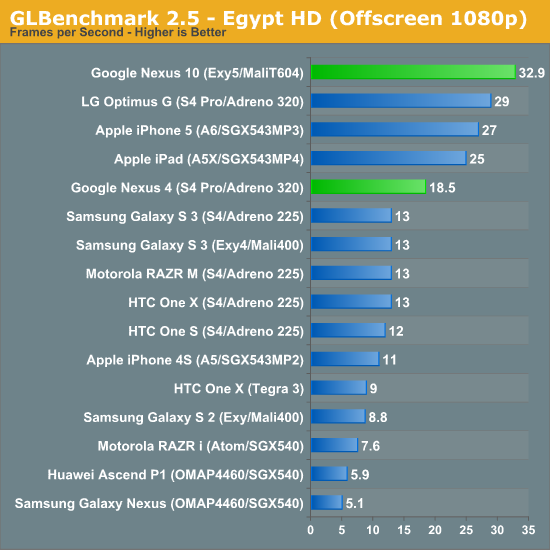
Normalize resolution and the Mali-T604 actually does very well here, setting a new performance record. Despite being based on the same hardware, the Optimus G is able to post a much higher score here than the Nexus 4. The explanation is simple: the Optimus G can't complete a single, continuous run of GLBenchmark 2.5 - the app will run out of texture memory and crash if you try to run through the entire suite in a single setting. The outcome is that the Optimus G avoids some otherwise nasty throttling. The Nexus 4 on the other hand manages to complete everything, but likely quickly throttles its clocks down due to thermal constraints. The Nexus 4 was really hot by the end of our GLBenchmark run, which does point to some thermal throttling going on here. I do wonder if the Snapdragon S4 Pro is a bit too much for a smartphone, and is better suited for a tablet at 28nm.
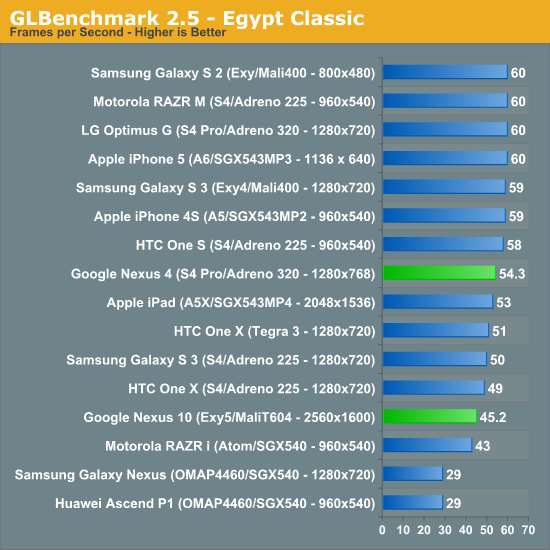
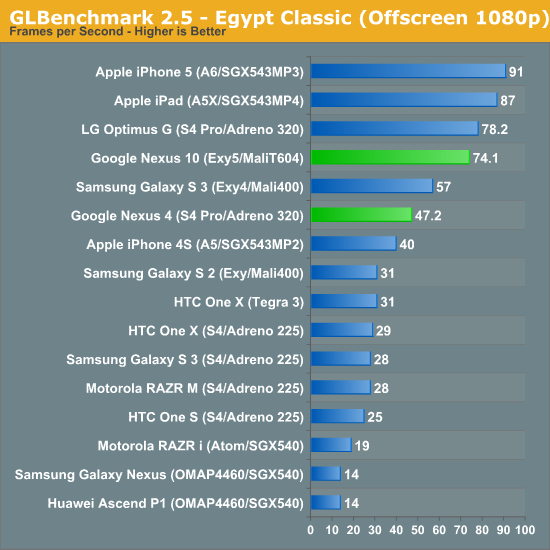
The Egypt Classic numbers are less interesting, but both platforms do well here.
Battery Life
We didn't have time to run through our entire battery life suite, but we do have some relevant results for the two devices. For smartphones, these are our latest web browsing battery life tests:
We regularly load web pages at a fixed interval until the battery dies (all displays are calibrated to 200 nits as always). The differences between this test and our previous one boil down to the amount of network activity and CPU load.
On the network side, we've done a lot more to prevent aggressive browser caching of our web pages. Some caching is important otherwise you end up with a baseband test, but it's clear what we had previously wasn't working. Brian made sure that despite the increased network load, the baseband still had the opportunity to enter its idle state during the course of the benchmark.
We also increased CPU workload along two vectors: we decreased pause time between web page loads and we shifted to full desktop web pages, some of which are very js heavy. The end result is a CPU usage profile that mimics constant, heavy usage beyond just web browsing. Everything you do on your smartphone ends up causing CPU usage peaks - opening applications, navigating around the OS and of course using apps themselves. Our 5th generation web browsing battery life test should map well to more types of smartphone usage, not just idle content consumption of data from web pages.
As always we test across multiple air interfaces (3G, 4G LTE, WiFi), but due to the increased network load we actually find that on a given process technology we see an increase in battery life on faster network connections. The why is quite simple to understand: the faster a page is able to fully render, the quicker all components can drive down to their idle power states.
All Android tests use Chrome and 5GHz WiFi unless otherwise listed.
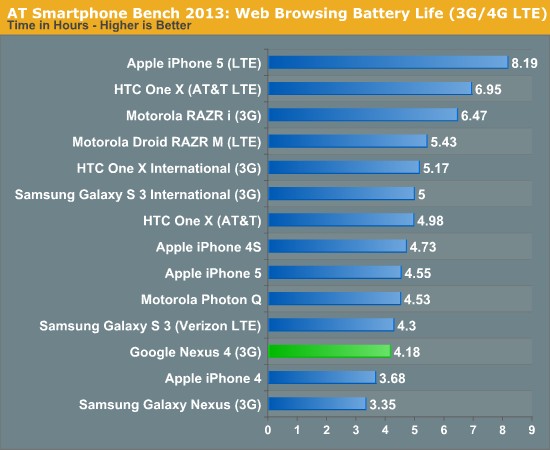
The Nexus 4 doesn't break any records for 3G battery life, it ends up relatively low on our list - even the Galaxy S 3 manages to do better here on 3G.

WiFi battery life is similar to the Galaxy S 3, but again it's not all that impressive compared to some of the other devices in this list.
Our tablet web browsing battery life test isn't directly comparable to the new smartphone tests, so we've got a separate chart for the Nexus 10:
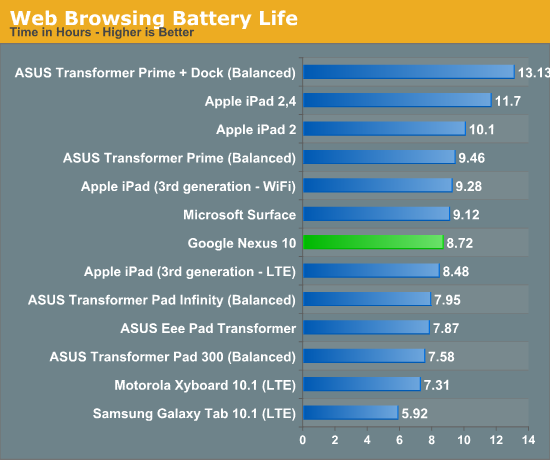
Despite driving a very high res panel, Google is able to deliver relatively competitive battery life with the Nexus 10. Battery capacity is around 80% the size of the 3rd gen iPad and battery life is around 93% of what Apple delivers here. Over 10 hours would be nice to have, but 8 hours of use in this test isn't bad at all. We'll have to do more testing to understand Exynos 5's power behavior a bit better, but so far it doesn't seem that the platform is all that bad from a power consumption standpoint. It remains to be seen how gracefully the Nexus 10 will handle being taxed heavier.
Display
We're still running our big display analysis routines on the new Nexus devices, but the brightness/contrast data below is a little teaser:
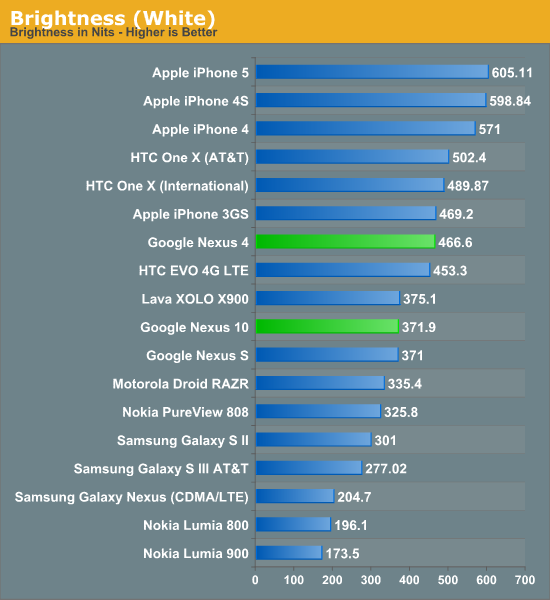
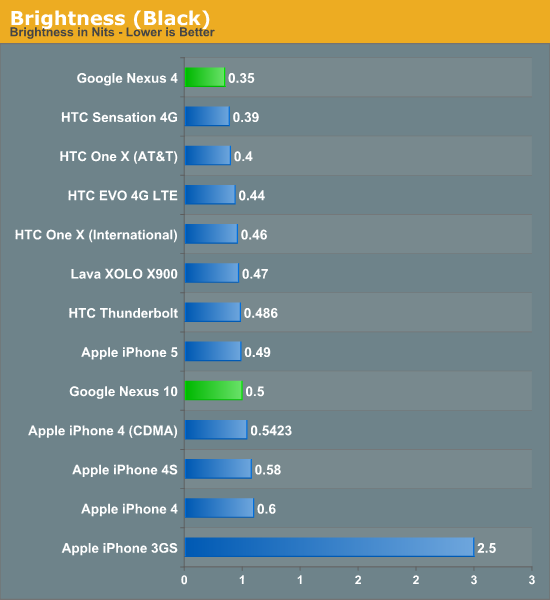
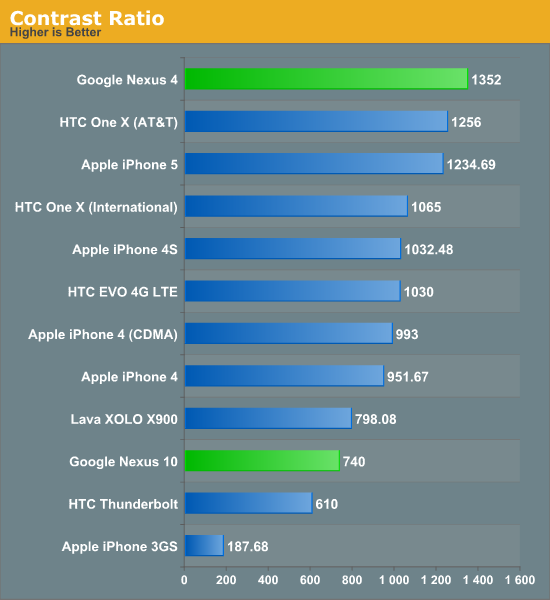
Final Words
We still have a lot of additional writing and testing ahead of us. Stay tuned for our full review of both devices!










244 Comments
View All Comments
doobydoo - Wednesday, November 7, 2012 - link
'So just because Apple claimed a 2x performanceincrease, we should have blindly believed them?
Finally you show your bias...
(as for me, NOW THAT I'VE SEEN TESTS of the iPad 4, I have no problem calling it King of the Hill of GPU performance).'
Given that the iPad 3 and iPhone 5 already beat this Nexus 10 in most of these benchmarks, it would only have taken a 10% bump for the iPad 4 to dominate. Apple claimed 2x and has a track record of providing accurate estimates. Thus you'd have to be illogical and biased to claim any other outcome. That is obvious, and clear. And yes, you're right, the iPad 4 absolutely destroys the Nexus 4 and 10.
'Says who?
On what are you basing such claims?'
Um, your whole point was how bad Quadrant scores are and how irrelevant they are, and your exact original claims depend on the accuracy of GL benchmarks. So you're criticising the very thing your point depends on.
'NO, if you knew how one of such tests was implemented, or had any idea of how to write one, you'd know that such synthetic benchmarks stress ONE SINGLE aspect in isolation, creating totally unrealistic conditions.'
I never said they didn't. I'm a 3D game designer, and I myself have written numerous benchmarks. If YOU had a clue, you would know that the individual aspects being broken down IS valuable because depending on the complexity and features of the scene being rendered, those different aspects are tested to different extents. It's clearly the combination of the entire pipeline which leads to the end result, but there's a reason your suggestion involves multiple games - they don't all require the same performance in all aspects. That's why you selecting the only benchmark the Nexus 10 beats a phone, is ridiculous. Especially given that there's another benchmark which uses the full pipeline and which it comfortably loses on.
'Open any PC graphic card review on Anandtech or reputable competing sites.
And yes FPS is not the only measure of perfomance, but since you cannot change quality settings on mobile phone games, the quality argument doesn't hold candle here.'
You completely missed the point. I was asking you to show me the FPS results. Of all the games. The whole point is that there AREN'T ANY, so we can't use that benchmark, so the GL benchmark range is the best we have. The fact that you can't change the graphics settings is irrelevant. If your phone performance being poor means you can't play games at as high quality, you're losing out as a customer. Even if it plays at a resolution of 1x1 at 6,000 FPS. Such a primitive excuse to say that just because the quality is locked, it doesn't matter. Absurd, in fact. Fanboy excuses all over.
'The Chromebook runs a DIFFERENT OS!
And a different SW stack!
That makes the difference!
But the LG Optimus G and the Google Nexus 4 ARE THE SAME PHONE on the SAME OS!
With the difference of phone storage size and SD Card slot.
And minor SW customizations.
There is no point about "same architecture", here we're talking about the exact same CPU!'
Nope, sorry, they have very different hardware aspects, the whole heatsink arrangement is fundamentally different. They also only share certain parts in common, not every element.
Final paragraph of yours is just you illustrating that the Nexus 4 being so poorly built that thermal issues come to the fore (exactly as they have done on the better heat-managed Optimus G) is a reason not to buy it.
The fact that even picking the best results for this phone from the most favourable reviews in the most favourable conditions (or even with the most favourable browser), it still loses out by a long way to the iPhone 5, with lower battery life, no LTE, lower storage capacities, glass back, AndroidAuthority articles on its poor build quality, are just making my point more and more.
xaml - Thursday, November 8, 2012 - link
Isn't it ironic that you would rely on some Android Authority article stating some XDA article which, as it seems, is pointless. http://www.reddit.com/r/Android/comments/12m8zc/ne...chippey5 - Wednesday, November 28, 2012 - link
Thanks pipper, we need more people like youmayankleoboy1 - Friday, November 2, 2012 - link
Just a stupid question : will a super fast memory card improve the battery life , compared to standard/cheap memory cards , compared to internal NAND.A5 - Friday, November 2, 2012 - link
I've never seen an SD card that's faster than internal NAND, so I really doubt it.mayankleoboy1 - Friday, November 2, 2012 - link
So how about faster MMC and a slower MMC ?Aenean144 - Friday, November 2, 2012 - link
It's doubtful. SSDs don't seem to improve battery life over HDDs that much, so that's a clue there.The dominant power consumers are 1) the display, 2) the radios (with cellular consuming more than WiFi), and 3) the SoC. Everything else is will be in the noise. You can theoretically take power consumption of the storage to zero, and it'll be in the noise of the said big 3 players.
rd_nest - Friday, November 2, 2012 - link
ARM says that the T604 @ 500MHz has a 2Gpixel/s fill rate. I believe the T604 in Exynos 5 is clocked at 533MHz.Why explains such a big difference in fill rate?
makken - Friday, November 2, 2012 - link
Wow, first glance the performance and battery life of the Nexus 4 seems disappointing compared to the iPhone 5. I was expecting something at least competitive.UpSpin - Friday, November 2, 2012 - link
Me too.I think the performance issues are software related, but battery life isn't really great, but hopefully can be improved with a software update, too.